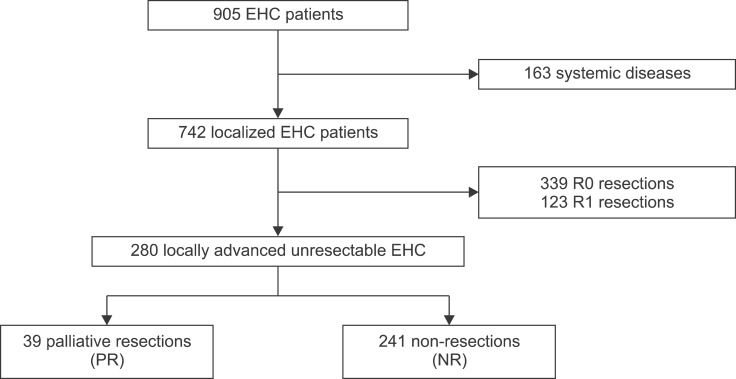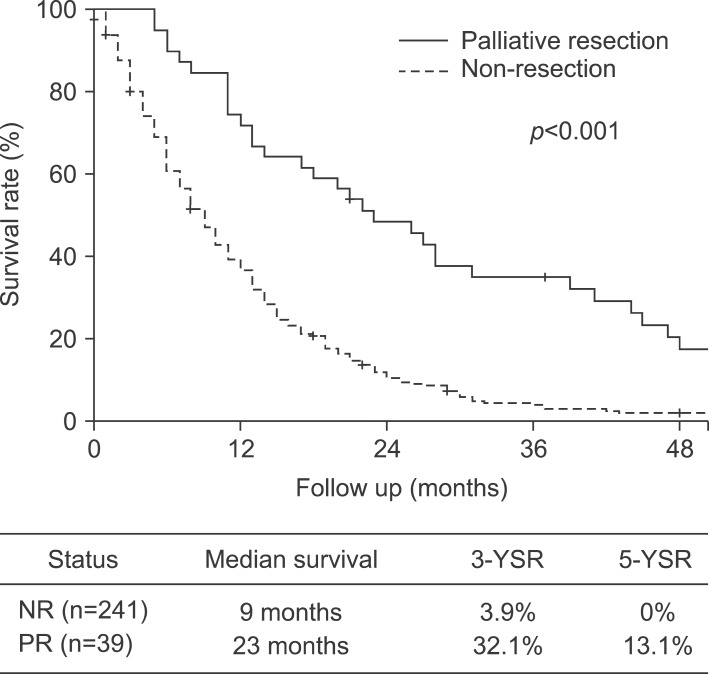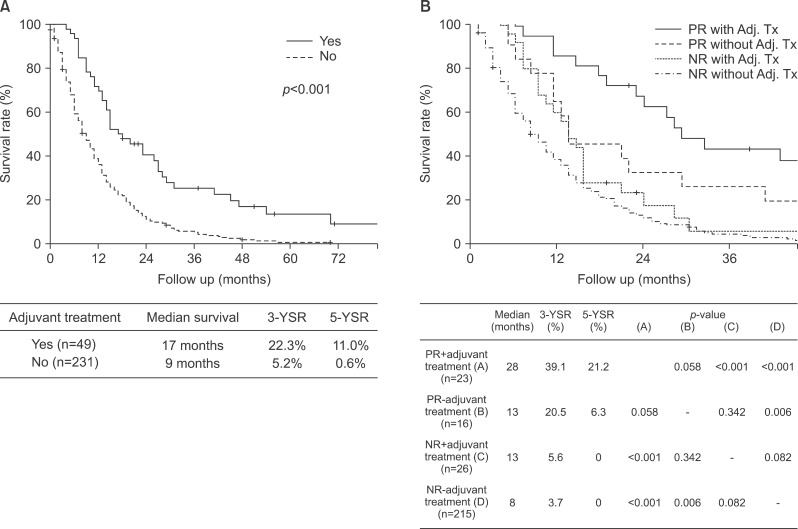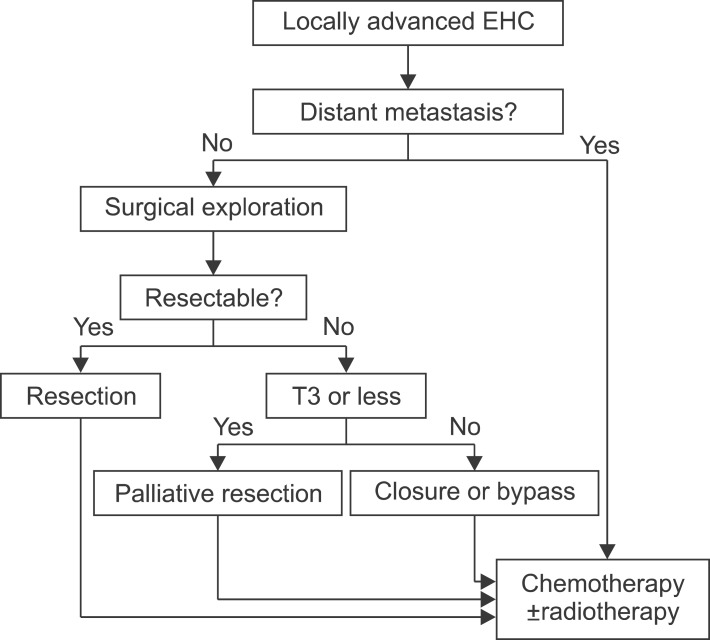Korean J Hepatobiliary Pancreat Surg.
2014 Feb;18(1):1-8. 10.14701/kjhbps.2014.18.1.1.
Clinical features and survival outcome of locally advanced extrahepatic cholangiocarcinoma
- Affiliations
-
- 1Department of Surgery, Seoul National University College of Medicine, Seoul, Korea. sunkim@plaza.snu.ac.kr
- KMID: 1890073
- DOI: http://doi.org/10.14701/kjhbps.2014.18.1.1
Abstract
- BACKGROUNDS/AIMS
Little is known about clinical features and survival outcome in locally advanced unresectable extrahepatic cholangiocarcinoma (EHC). The aim was to investigate the clinical features and the survival outcome in these patients, and to evaluate the role of palliative resections in locally advanced unresectable EHC.
METHODS
Between 1995 and 2007, 280 patients with locally advanced unresectable EHC were identified. Clinical, pathologic, and survival data were investigated. A comparative analysis was done between those who received palliative resection (PR) and those who were not operated on (NR).
RESULTS
The overall median survival of the study population was 10+/-1 months, and the 3- and 5-year survival rates (YSR) were 8.5% and 2.5%, respectively. The median survival, 3- and 5-YSR of PR were 23 months, 32.1% and 13.1%, respectively. For NR, they were 9 months, 3.9% and 0%, which were significantly worse than PR (p<0.001). In univariate analysis, T classification, N classification, tumor location, palliative resection, adjuvant treatment, chemotherapy, and radiation therapy were factors that showed survival difference between PR and NR. Regional lymph node metastasis (RR, 2.084; 95% CI, 1.491-2.914; p<0.001), non-resections (RR, 2.270; 95% CI, 1.497-3.443; p<0.001), and no chemotherapy (RR, 1.604; 95% CI, 1.095-2.349; p=0.015) were identified as risk factors for poor outcome on multivariate analysis.
CONCLUSIONS
Without evidence of systemic disease, palliative resection may provide some survival benefit in selected locally advanced unresectable EHCs and adjuvant treatment may further improve survival outcome.
MeSH Terms
Figure
Reference
-
1. Nakeeb A, Pitt HA, Sohn TA, et al. Cholangiocarcinoma. A spectrum of intrahepatic, perihilar, and distal tumors. Ann Surg. 1996; 224:463–473. PMID: 8857851.2. Khan SA, Toledano MB, Taylor-Robinson SD. Epidemiology, risk factors, and pathogenesis of cholangiocarcinoma. HPB (Oxford). 2008; 10:77–82. PMID: 18773060.
Article3. Shaib Y, El-Serag HB. The epidemiology of cholangiocarcinoma. Semin Liver Dis. 2004; 24:115–125. PMID: 15192785.
Article4. Vern-Gross TZ, Shivnani AT, Chen K, et al. Survival outcomes in resected extrahepatic cholangiocarcinoma: effect of adjuvant radiotherapy in a surveillance, epidemiology, and end results analysis. Int J Radiat Oncol Biol Phys. 2011; 81:189–198. PMID: 20971573.
Article5. Seyama Y, Makuuchi M. Current surgical treatment for bile duct cancer. World J Gastroenterol. 2007; 13:1505–1515. PMID: 17461441.
Article6. Jang JY, Kim SW, Park DJ, et al. Actual long-term outcome of extrahepatic bile duct cancer after surgical resection. Ann Surg. 2005; 241:77–84. PMID: 15621994.
Article7. Blom D, Schwartz SI. Surgical treatment and outcomes in carcinoma of the extrahepatic bile ducts: the University of Rochester experience. Arch Surg. 2001; 136:209–215. PMID: 11177143.8. Otani K, Chijiiwa K, Kai M, et al. Outcome of surgical treatment of hilar cholangiocarcinoma. J Gastrointest Surg. 2008; 12:1033–1040. PMID: 18085342.
Article9. Jarnagin WR, Fong Y, DeMatteo RP, et al. Staging, resectability, and outcome in 225 patients with hilar cholangiocarcinoma. Ann Surg. 2001; 234:507–517. PMID: 11573044.
Article10. Witzigmann H, Berr F, Ringel U, et al. Surgical and palliative management and outcome in 184 patients with hilar cholangiocarcinoma: palliative photodynamic therapy plus stenting is comparable to r1/r2 resection. Ann Surg. 2006; 244:230–239. PMID: 16858185.11. Schiffman SC, Reuter NP, McMasters KM, et al. Overall survival peri-hilar cholangiocarcinoma: R1 resection with curative intent compared to primary endoscopic therapy. J Surg Oncol. 2012; 105:91–96. PMID: 21815152.
Article12. Ito F, Agni R, Rettammel RJ, et al. Resection of hilar cholangiocarcinoma: concomitant liver resection decreases hepatic recurrence. Ann Surg. 2008; 248:273–279. PMID: 18650638.13. Jarnagin WR, Bowne W, Klimstra DS, et al. Papillary phenotype confers improved survival after resection of hilar cholangiocarcinoma. Ann Surg. 2005; 241:703–712. PMID: 15849506.
Article14. Nakeeb A, Tran KQ, Black MJ, et al. Improved survival in resected biliary malignancies. Surgery. 2002; 132:555–563. PMID: 12407338.
Article15. Kawasaki S, Imamura H, Kobayashi A, et al. Results of surgical resection for patients with hilar bile duct cancer: application of extended hepatectomy after biliary drainage and hemihepatic portal vein embolization. Ann Surg. 2003; 238:84–92. PMID: 12832969.16. Kosuge T, Yamamoto J, Shimada K, et al. Improved surgical results for hilar cholangiocarcinoma with procedures including major hepatic resection. Ann Surg. 1999; 230:663–671. PMID: 10561090.
Article17. Miyazaki M, Ito H, Nakagawa K, et al. Aggressive surgical approaches to hilar cholangiocarcinoma: hepatic or local resection? Surgery. 1998; 123:131–136. PMID: 9481397.
Article18. Hemming AW, Reed AI, Fujita S, et al. Surgical management of hilar cholangiocarcinoma. Ann Surg. 2005; 241:693–699. PMID: 15849505.
Article19. Pichlmayr R, Weimann A, Klempnauer J, et al. Surgical treatment in proximal bile duct cancer. A single-center experience. Ann Surg. 1996; 224:628–638. PMID: 8916878.20. Klempnauer J, Ridder GJ, von Wasielewski R, et al. Resectional surgery of hilar cholangiocarcinoma: a multivariate analysis of prognostic factors. J Clin Oncol. 1997; 15:947–954. PMID: 9060532.
Article21. Takada T, Amano H, Yasuda H, et al. Is postoperative adjuvant chemotherapy useful for gallbladder carcinoma? A phase III multicenter prospective randomized controlled trial in patients with resected pancreaticobiliary carcinoma. Cancer. 2002; 95:1685–1695. PMID: 12365016.22. Pitt HA, Nakeeb A, Abrams RA, et al. Perihilar cholangiocarcinoma. Postoperative radiotherapy does not improve survival. Ann Surg. 1995; 221:788–797. PMID: 7794082.
Article23. Borghero Y, Crane CH, Szklaruk J, et al. Extrahepatic bile duct adenocarcinoma: patients at high-risk for local recurrence treated with surgery and adjuvant chemoradiation have an equivalent overall survival to patients with standard-risk treated with surgery alone. Ann Surg Oncol. 2008; 15:3147–3156. PMID: 18754070.
Article24. Gwak HK, Kim WC, Kim HJ, et al. Extrahepatic bile duct cancers: surgery alone versus surgery plus postoperative radiation therapy. Int J Radiat Oncol Biol Phys. 2010; 78:194–198. PMID: 19910130.
Article25. Ben-David MA, Griffith KA, Abu-Isa E, et al. External-beam radiotherapy for localized extrahepatic cholangiocarcinoma. Int J Radiat Oncol Biol Phys. 2006; 66:772–779. PMID: 17011452.
Article
- Full Text Links
- Actions
-
Cited
- CITED
-
- Close
- Share
- Similar articles
-
- Intrahepatic Cholangiocarcinoma: Evolving Concepts and Medical Treatment
- The role of down staging treatment in the management of locally advanced intrahepatic cholangiocarcinoma: Review of literature and pooled analysis
- Mucin-hypersecreting Cholangiocarcinoma causing Obstructive Jaundice
- Pathologic Complete Remission in a Patient with Locally Advanced Unresectable Intrahepatic Cholangiocarcinoma Treated with Chemotherapy
- Comparison of the clinical results of surgical resection for extrahepatic cholangiocarcinomas: Hilar cholangiocarcinoma and mid-to-distal cholangiocarcinoma






